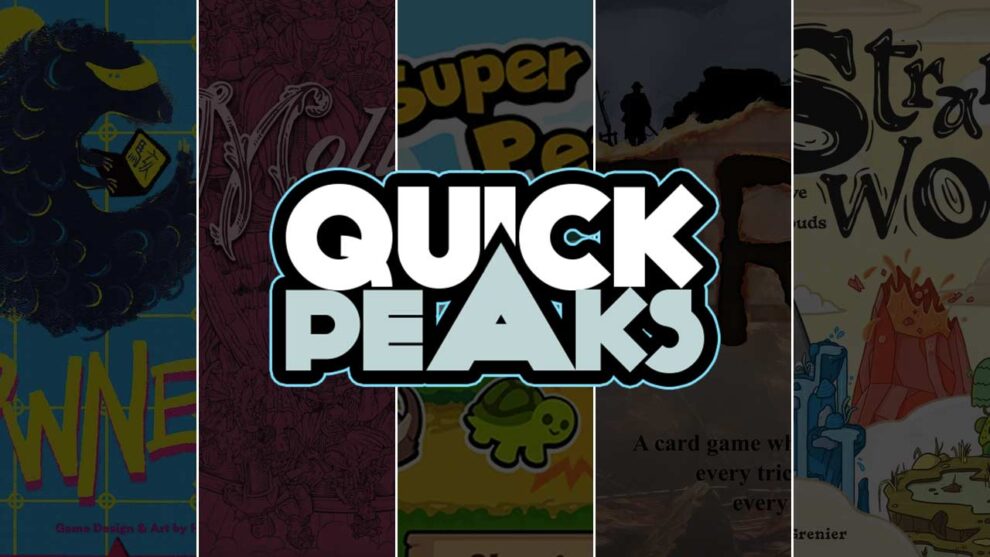PWNED! – Andrew Lynch
I have no interest whatsoever in playing PWNED! again. I can’t figure out why. This abstract game with hidden information doesn’t have anything obviously wrong with it. Is it too slow? Possible. Your first several turns are uninteresting, free of interaction. Is the goal too boring? Also possible. You need to get from one end of the board to the other. That’s not the most exciting thing.
It does spice things up by introducing traps, pieces that your opponent can capture at their peril. The presence of those pieces allows for some fun opportunities, some bluffing. During one game, I made a move that wouldn’t have made sense if I weren’t adding one of those traps. I was not, in fact, adding a trap, but the move threw off my opponent.
Still, I can’t find it in me to revisit the game. I have no interest. Some games are boring, even if they’re executed well. I think PWNED! may be one of those.
Ease of entry?
★★★★☆ – The odd bump or two
Would I play it again?
★☆☆☆☆ – Would play again but will cry about it
Read more articles from Andrew Lynch.
Molly House – Justin Bell
Because the small publisher Wehrlegig Games releases such high-profile historical titles, I knew that I had to eventually try their 2025 release Molly House, designed by Jo Kelly, Cole Wehrle and Ricky Royal. (The game was published by Wehrlegig after it won the 2021 Zenobia Award for its design.) Wehrlegig’s first two titles are updated second editions of other titles, but Molly House is their first release of an original, first edition of a game. Marketed as “a game of queer community and betrayal”, Molly House has the theme-rich look and the production chops of their previous games. From the pawns to the card stock to the extravagant board, player aids, and artwork, Molly House is another excellent example of why we are in the golden age of board game production.
We are also, apparently, in the golden age of edge-case rules, because during my recent three-player game I was shocked at how many minor rules we had to backtrack and correct to ensure we stayed on course. (“Where does this card get discarded to, again?” was a question posed at least a dozen times during this first play.) The game is set in the early 1700s, where players attempt to navigate the “molly houses” of Georgian London to secretly engage with other members of the queer community, all while trying to avoid the constables and local members of the Society of Reformation of Manners to keep your desires secret and your life free from danger. Victory points are “joy”, one or more players can turn snitch, and throwing festivities is the best way to advance the agenda…if, of course, you are not hanged thanks to one of the game’s three victory conditions.
I love the theme here and I love that, somehow, all of this is essentially boiled down to a card game. A card game with a shocking array of rules, but still, a card game. The flavor art on the cards (illustrations by Rachel Ford) and on the main board are gorgeous, and it did really feel like I was trying to duck and dive from having my desires exposed…the level of immersion here is great. But as a one-off play, I’m not sure where I land. Despite scoring what felt like a load of points and making it to the fifth of five rounds in great shape, our win condition was hosed when one of the molly houses was raided a second time, sending all players to an instant loss. (Had I gone snitch, I would have won, though.) Knowing that we invested time in a game that ultimately ended in a table-wide loss was only a minor issue for me, since the experience was interesting. I’m just not sure I’m getting Molly House to the table regularly enough to sort out the best ways to play it, and while it was interesting at three players, I have a sneaking suspicion it is best at the full player count of five to boost the level of drama and, well, snitching.
Ease of entry?
★★☆☆☆ – Not an easy onboard
Would I play it again?
★★★☆☆ – Wouldn’t suggest it, but would happily play it
Read more articles from Justin Bell.
Super Auto Pets Card Battle – Andy Matthews
Several years ago one of my sons introduced me to a whimsical browser based game called Super Auto Pets, the premise of which was that you acquired pets and then sent them up against an opponent to battle each other. Pets have health and power, and almost every pet has some special ability (throwing rocks, acting as a shield for other pets, etc.)—similar to the card game War, but with lots of modifications. Imagine my surprise when Plaid Hat Games sent me a press announcement about their upcoming Kickstarter campaign for Super Auto Pets Card Battle.
In Super Auto Pets Card Battle, two players go head to head in a pseudo deck-building competition to see whose menagerie is the strongest. The game is broken up into 6 rounds, each of which has a dedicated deck with animals whose strength and capabilities increase as the game progresses. Players spend up to three gold to purchase pets from the marketplace, sell previously purchased pets to acquire apples (which increase power), or perform the triple action which allow you to acquire pets from a future deck. Once all players are ready, they arrange their deck in whatever order they choose, and then start flipping cards.
Once the battle begins, the “auto” portion of the game name is highlighted. Players flip over cards until two pets are face to face. Each pet does damage, equal to its power, to the opposing pet. If the damage is equal to or greater than the power of that pet, then it “faints” and is defeated. Fainted pets are set aside and new cards are drawn until both players have a pet in front of them. The game progresses until one player has no more pets in their deck. When that happens the winning player receives that round’s trophy, and the next round begins.
Super Auto Pets Card Battle artwork is adorable—for real though, if you’ve played the original digital game on iOS, Android, Steam, or in your browser, then you’ll feel right at home. I won’t say that Super Auto Pets Card Battle is deep, but there’s a surprising amount of strategy involved: mostly around attempting to outthink your opponent. The goal being to arrange your deck in a way that minimizes your players strengths, while maximizing your own. If you’re already a fan of this game, or have younger kids, then backing this campaign is a no-brainer. You’ll have a blast.
Ease of entry?
★★★★☆ – The odd bump or two
Would I play it again?
★★★★☆ – Would like to play it again
Read more articles from Andy Matthews
Verdun – Kevin Brantley
This indie game was on my Gen Con radar thanks to the mash-up of two of my interests: WWI and trick-taking. Most historical games lean toward wargames, so it’s refreshing to see the setting framed in a different context. The game re-enacts the famous Battle of Verdun, the longest battle of the war (nine months!) between French and German forces. Combined, there were nearly a million casualties, making it the bloodiest battle of the war.
In this simulation, players take the role of one of the two forces, trying to secure the opponent’s strategic assets without losing too many of their own troops. Played either 1v1 or 2v2, players hold cards from both forces and play them in sequence, as in a standard trick-taking game. High cards may win tricks but also carry a skull (negative points), representing casualties. Winning tricks comes at a cost, as the game is very much a war of attrition.
The art is fantastic, featuring colorized propaganda posters from the opposing nations. However, the intrigue stops there. The game itself is fine—just as much deduction as trick-taking. Because both players have access to each other’s cards, it can be strategic to let them win or lose certain tricks in order to force more casualties. Players also earn tactical cards, powerful options that can swing outcomes, featuring some of the deadliest weapons of the war, like mustard gas and artillery.
In the 2v2 mode, information is hidden from your partner, so there’s a layer of mind-reading when strategizing a trick. The gameplay ultimately feels more like hand management than traditional trick-taking. While not overly complex, it’s very luck-reliant, and card distribution can cause major swings due to the wide value ranges. In the end, the winner is whoever best mitigates casualties rather than simply winning the most tricks.
I applaud the game for its innovative take on WWI. I’d recommend it if the theme stands out to you, but overall, it left me feeling lukewarm.
Ease of entry?
★★★☆☆ – There were a few questions
Would I play it again?
★★☆☆☆ – Would play again but would rather play something else
Read more articles from Kevin Brantley.
Strange World Above the Clouds – Kevin Brantley
I love small box card games. Portability and a small footprint are important, especially if you want to play something while traveling. Here we’ve got something small but, more importantly, mighty.
This is a simple card-drafting game where you create a 4×4 grid of cards that score based on different conditions. Mountains score for the largest group, water for surrounding cards, animals through set collection, and so on. But it goes a bit deeper. Portals can be created by matching two sides, allowing a “visitor” to enter for additional end-game scoring. Volcanoes can also erupt, nullifying a previously played card. Cards even come with placement restrictions, meaning some spots are off-limits. Can’t place a card? It flips over and becomes a world-eating monster (whose art is actually kind of cute) that also nullifies a card spot.
It’s nothing groundbreaking, but it’s a nice time. No scoring condition feels overly powerful, and there’s a sweet opportunity to hate-draft and skunk your opponents. There’s always a race to claim visitors, and they provide a satisfying boost of end-game points.
Pair that with some eye-popping art, and you’ve got a solid filler, perfect for gaming on the go. As a bonus, the solo mode offers a fun challenge and keeps you coming back to beat your own score.
Ease of entry?
★★★★★ – No sweat
Would I play it again?
★★★★☆ – Would like to play it again
Read more articles from Kevin Brantley.












